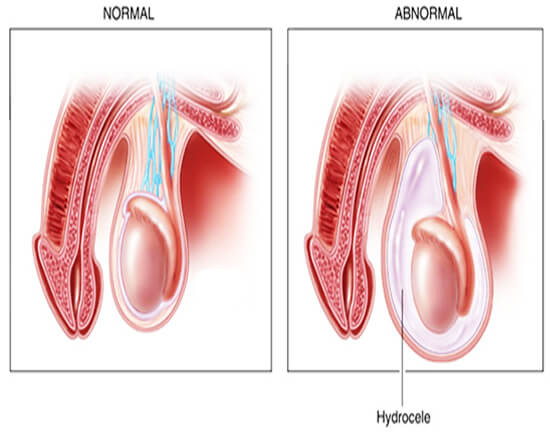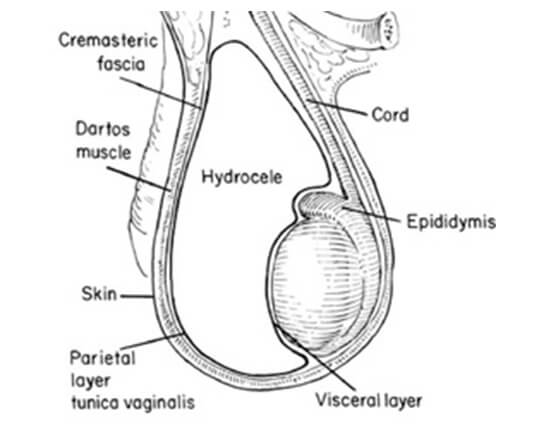What is Hydrocele?
Hydrocele is the painless buildup of fluid in one or both the testicles. This accumulation of a watery fluid gives rise to a scrotal swelling. The problem is common in infants and usually subsides on its own within the first year of life. However, it can affect men at any age. The condition often resolves without any treatment, but if it prevails for long, you must consult a doctor to rule out possibilities of other dreadful diseases such as testicular cancer.
If your partner has swollen Testicles that looks like a water balloon then your partner must be suffering from Hydrocele. He must be at the initial stage of Hydrocele.
Clinical Definition
Hydrocele is a very serious and irritating medical condition.
In this condition, the Serious Liquid is accumulated in the body cavity that makes a liquid-filled sac along with the Spermatic Cord inside Scrotum. Hydrocele is also known as Patent Processus Vaginalis or Processus Vaginalis.

Symptoms
Hydrocele is a painless lump that may arise on both sides of Testicles.
Hydrocele is very common in newborn babies and disappears with the passage of time. It does not create any complications in the newborns. Here are some common symptoms.
Lump on the sides of Testicles.
Pain in the lump.
Swelling in the Testicles.
Causes
In a healthy person, the testicles go down from Abdomen to the Scrotum. The Hydrocele sac appears when this tube does not close in the Scrotum. So the Serous Fluid flows down from the Abdomen and starts collecting in the Scrotum. This fluid causes inflammation in the Scrotum.
The strange buildup of serous fluid may appear because of inflammation or injury to the testicle or Epididymis is a tube that carries Sperm.
The presence of blood or fluid in the Spermatic cord can also cause Hydrocele.
The disease of Hydrocele is common in old people.
Hydrocele can also be associated with the Inguinal Hernia. Inguinal Hernia is a type of Hernia in which an Intestinal Loop moves in the Inguinal Canal. This Hernia is common in Males.
Diagnosis
The doctor diagnoses the Hydrocele with the physical examination. The doctor usually finds a hard Swollen Scrotum. In this case, the Testicles cannot be felt due to the presence of fluid around it. It is found that applying pressure on the Scrotum can increase or decrease the size of liquid-filled sac on the sides of Testicles. Hydrocele examination is also done by Transillumination. In this process, a flashlight is put on the Scrotum and if Scrotum is filled with the liquid the light passes through it.
Other Tests
The Sonography and the Ultrasound tests are also used to diagnose the Hydrocele. It also helps us to differentiate between Hydroceles and Spermatoceles.
Sonography tells us about the flow of blood in the Testicles.
There are few diseases which are different from Hydrocele but they can also give rise to the Scrotal swelling and they are
Hernia
Testicular teratoma
Varicocele
Epididymo- Orchitis
Epididymal Cyst
Morgagni Hydatid
Treatment:
Hydrocele is not dangerous and it does not require treatment unless they cause irritation. When the lumps become large and causes blood obstruction then the treatment becomes necessary. Sometimes the problem of Hydrocele has resolved itself.
Following are the treatments of Hydrocele
Needle Aspiration
In this treatment, a surgical needle is used to drain the fluid from the Testicles. This treatment is mostly used on those patients who have health from sue to the surgery. It is the best cure of Hydrocele without surgery.
Use of medications
Medicines can also be used to prevent the accumulation of fluids in the Testicles and it helps in the treatment of Hydrocele.
Surgery
If the Hydrocele is linked to the Inguinal Hernia then it has been removed through surgery. This surgical method is known as hydrocelectomy. It is a simple surgery but it should be carried out by an expert surgeon.
Complications in Hydrocele
The treatment of Hydrocele can cause other complications. The surgery and medications for the treatment of Hydrocele can lead to a problem known as Fibrosis. The excess fibrous connective tissues are developed in Fibrosis.
Side Effects of Hydrocele’s Operation:
Infection
Injury to Testicles
The trauma of Scrotal Tissues
Blood Clots in Scrotum.
Hydrocele and Infertility:
If the surgery for Hydrocele is not done properly and injury is caused to the Vas Deferens then it can lead to Infertility however, the rate of Infertility is rare in Hydrocele.
Hydrocele Management:
In infants, the Hydrocele resolves within a year. The parents should take notice of the Testicles whether the lump gets larger or is the same in size. If the Hydrocele is left untreated, it can cause infection of the Serous Fluid in the Testes; the lump may swell and can block the blood to the Testicles. It ultimately causes Infertility in the men.
In order to avoid the embarrassment at the later stages the Hydrocele should be treated soon otherwise it can lead to Infertility in the future.
If you are suffering from Hydrocele and want safe, effective treatment, do contact us.

